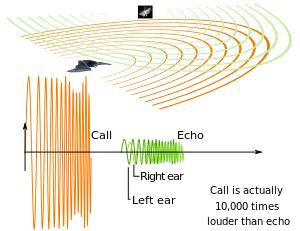Animal echolocation

Echolocation, also called bio sonar, is the biological sonar used by several kinds of animals. Echolocating animals emit calls out to the environment and listen to the echoes of those calls that return from various objects near them. They use these echoes to locate and identify the objects. Echolocation is used for navigation and for foraging (or hunting) in various environments. Some blind humans have learned to find their way using clicks produced by a device or by mouth.
Echolocating animals include some mammals and a few birds; most notably microchiropteran bats and odontocetes (toothed whales and dolphins), but also in simpler form in other groups such as shrews, one genus of megachiropteran bats (Rousettus) and two cave dwelling bird groups, the so-called cave swiftlets in the genus Aerodramus (formerly Collocalia) and the unrelated Oilbird Steatornis caripensis.
Bats
Microbats use echolocation to navigate and forage, often in total darkness. They generally emerge from their roosts in caves, attics, or trees at dusk and hunt for insects into the night. Their use of echolocation allows them to occupy a niche where there are often many insects (that come out at night since there are fewer predators then), less competition for food, and fewer species that may prey on the bats themselves.
Microbats generate ultrasound via the larynx and emit the sound through the open mouth or, much more rarely, the nose. The latter is most pronounced in the horseshoe bats (Rhinolophus spp.). Microbat  calls (help·info) range in frequency from 14,000 to well over 100,000 Hz, mostly beyond the range of the human ear (typical human hearing range is considered to be from 20 Hz to 20,000 Hz). Bats may estimate the elevation of targets by interpreting the interference patterns caused by the echoes reflecting from the tragus, a flap of skin in the external ear.[9] There are two hypotheses about the evolution of echolocation in bats. The first suggests that laryngeal echolocation evolved twice in Chiroptera, once in theYangochiroptera and once in the Horseshoe bats (Rhinolophidae).[10][11] The second proposes that laryngeal echolocation had a single origin in Chiroptera, was subsequently lost in the family Pteropodidae (all megabats), and later evolved as a system of tongue-clicking in the genusRousettus.[12]
calls (help·info) range in frequency from 14,000 to well over 100,000 Hz, mostly beyond the range of the human ear (typical human hearing range is considered to be from 20 Hz to 20,000 Hz). Bats may estimate the elevation of targets by interpreting the interference patterns caused by the echoes reflecting from the tragus, a flap of skin in the external ear.[9] There are two hypotheses about the evolution of echolocation in bats. The first suggests that laryngeal echolocation evolved twice in Chiroptera, once in theYangochiroptera and once in the Horseshoe bats (Rhinolophidae).[10][11] The second proposes that laryngeal echolocation had a single origin in Chiroptera, was subsequently lost in the family Pteropodidae (all megabats), and later evolved as a system of tongue-clicking in the genusRousettus.[12]
Individual bat species echolocate within specific frequency ranges that suit their environment and prey types. This has sometimes been used by researchers to identify bats flying in an area simply by recording their calls with ultrasonic recorders known as "bat detectors". However echolocation calls are not always species specific and some bats overlap in the type of calls they use so recordings of echolocation calls cannot be used to identify all bats. In recent years researchers in several countries have developed "bat call libraries" that contain recordings of local bat species that have been identified known as "reference calls" to assist with identification.
Since the 1970s there has been an ongoing controversy among researchers as to whether bats use a form of processing known from radar termedcoherent cross-correlation. Coherence means that the phase of the echolocation signals is used by the bats, while cross-correlation just implies that the outgoing signal is compared with the returning echoes in a running process. Today most - but not all - researchers believe that they use cross-correlation, but in an incoherent form, termed a filter bank receiver.
When searching for prey they produce sounds at a low rate (10-20 clicks/second). During the search phase the sound emission is coupled to respiration, which is again coupled to the wingbeat. This coupling appears to dramatically conserve energy as there is little to no additional energetic cost of echolocation to flying bats.[13] After detecting a potential prey item, microbats increase the rate of pulses, ending with the terminal buzz, at rates as high as 200 clicks/second. During approach to a detected target, the duration of the sounds is gradually decreased, as is the energy of the sound.

No comments:
Post a Comment